
When is a Curly not a Curly?

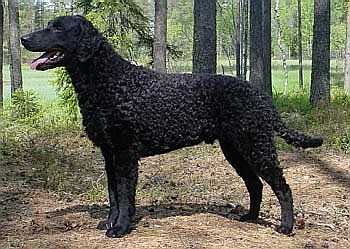
Some of the dogs that the Curly Coated Retriever is mistaken for
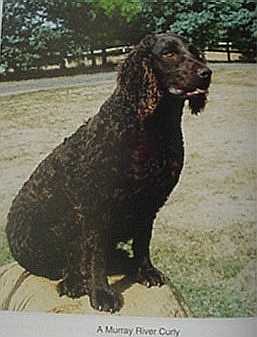
Murray River Curly
Murray River Curly is a smaller unregistered liver curly type dog in Australia that has been around since the turn of the century. More spaniel-like in appearance,
considerably shorter on leg, with larger ears, and a looser coat.
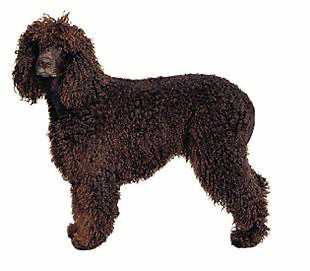
The Irish Water Spaniel
The Irish Water Spaniel is often called the clown of the spaniel family. The so-called "rat-tail" is a striking characteristic of the breed. Dogs 22 to 24 inches, bitches
21 to 23 inches. The breed has a liver colored double coat.
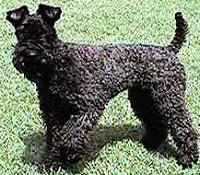
Kerry Blue Terrier
The Kerry is an all-round working and utlity terrier. The breed was used in Ireland and England for hunting small game and birds, and for retrieving from land and water. 18-19� inches for a dog, and 17�-19 inches for a bitch. The Coat is soft, dense and wavy.
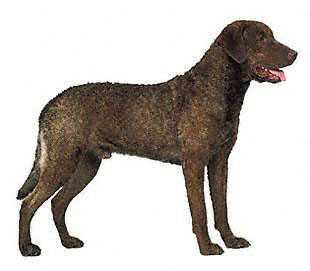
The Chesapeake Bay Retriever
The Chesapeake Bay Retriever originated in the United States. Coat should be thick and short, nowhere over 1� inches long, with a dense fine wooly undercoat.
Hair on the face and legs should be very short and straight with a tendency to wave on the shoulders, neck, back and loins only. Moderate feathering on rear of
hindquarters and tail is permissible.
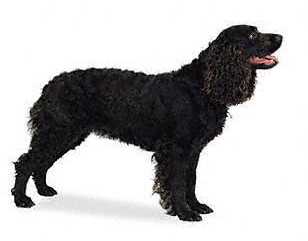
American Water Spaniel
The American Water Spaniel was the first breed developed in the United States as an all-around hunter that could retrieve from boats. (they look very much like the Murray River Curly) 15 to 18 inches for either sex. Males weighing 30-45 lbs. Females weighing 25-40 lbs. Coat can range from marcel (uniform waves) to closely curled. The amount of waves or curls can vary from one area to another on the dog. It is important to have undercoat to provide sufficient density to be of protection against weather, water or punishing cover, yet not too coarse or too soft.
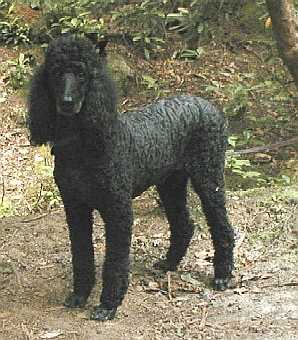
The Standard Poodle
The Standard Poodle is over 15 inches at the highest point of the shoulders. They come in a variety of colors and coat clips. Standard Poodles are possibly the oldest documented water retriever breed.
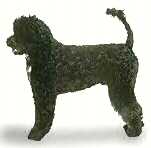
Portuguese Water Dog
The Portuguese Water Dog once existed all along Portugal's coast, where it was taught to herd fish into the nets, to retrieve lost tackle or broken nets, and to act as
a courier from ship to ship, or ship to shore. Males, 20 to 23 inches. Females, 17 to 21 inches.
A profuse, thickly planted coat of strong, healthy hair, covering the whole body evenly, except where the forearm meets the brisket and in the groin area, where it is
thinner. No undercoat, mane or ruff. There are two varieties of coat: Curly--Compact, cylindrical curls, somewhat lusterless. The hair on the ears is sometimes
wavy. Wavy--Falling gently in waves, not curls, and with a slight sheen.
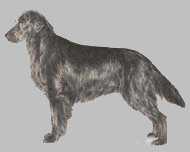
Flat-Coated Retriever
The Flat-Coated Retriever, like the Curly Coated Retriever comes in either solid black or solid liver. Preferred height is 23 to
24�; inches at the withers for dogs, 22 to 23� inches for bitches. Coat is of moderate length density and fullness, with a high lustre. The ideal coat is straight and flat
lying. A slight waviness is permissible but the coat is not curly, wooly, short, silky or fluffy.

Boykin Spaniel
The Boykin Spaniel was first bred by South Carolina hunters during the 1900's to provide the ideal dog for hunting ducks and wild turkeys in the Wateree River
Swamp.
The first Boykin spaniel, or the precursor of today's breed, was reportedly a small, stray spaniel type dog that befriended a banker walking from his home to the
First Presbyterian Church in Spartanburg, South Carolina around 1905-1910. The Boykin is 14 to 18 inches at the shoulder. The coat is flat to moderately curly
with medium length, fine hair with light feathering acceptable on the legs, feet, ears, chest, and belly.
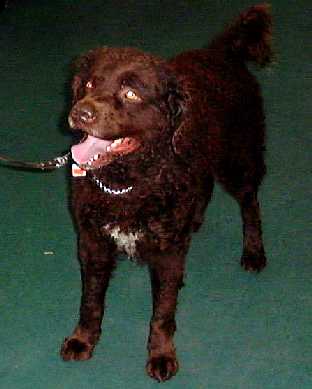
Wetterhond
Wetterhond is a native of the Netherlands and is slightly smaller than the Curly.
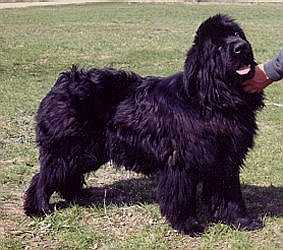
Newfoundland
The Newfoundlands webbed feet, water-resistant coat, and rudder-like tail make it an excellent swimmer. The Newfoundland is famous
for rescuing drowning people. Height: 26-28 inches. The adult Newfoundland has a flat, water-resistant, double coat that tends to fall back into place when rubbed
against the nap. The outer coat is coarse, moderately long, and full, either straight or with a wave.
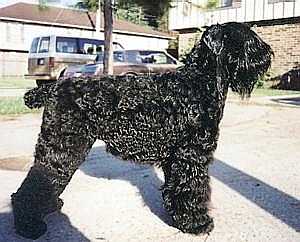
Black Russian Terrier
The Black Russian
Terrier was developed in Red Star kennel by reproductive crossing of proven and well compatible working breeds: Giant Schnauzer, Airedale Terrier, Rottweiler,
Newfoundland. The hair consists of a thick, woolly undercoat that is covered with a well connecting, hard top fur. The color is black or black with some grey hairs.
The coat has to be trimmed 3 to 4 times a year.

Labradoodle (Or other mutts)
A Labradoodle is a cross between the Labrador Retriever and Standard Poodle. With their popularity soaring, Labradoodles have become the "Breed du Jour" and pet stores, puppy mills and backyard breeders are capitalizing on it's fame, selling fluffy puppies of dubious parentage and breeding to an unsuspecting public world-wide.More about the Labradoodle
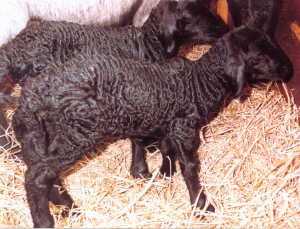
Sheep
The Karakul may be the oldest breed of domesticated sheep. Archeological evidence indicates the existence of the Persian lambskin as early as 1400 B.C. The
Karakul is distinguished by its colored fleece, which is due to a dominate black gene. Most lambs are born coal black with lustrous wavy curls, with the face, ears,
and legs usually showing smooth, sleek hair. As the lamb grows, the curls opens and loses its pattern and the color generally begins to turn brownish or bluish gray,
getting grayer with age.

Curly Coated Retriever
This smartly upstanding, multi-purpose hunting retriever is recognized by most canine historians as one of the oldest of the retrieving breeds. Developed in England, the Curly was long a favorite of English gamekeepers. Prized for innate field ability, courage and indomitable perseverance, a correctly built and tempered Curly will work as long as there is work to be done, retrieving both fur and feather in the heaviest of cover and the iciest of waters. To work all day a Curly must be balanced and sound, strong and robust, and quick and agile. Outline, carriage and attitude all combine for a grace and elegance somewhat uncommon among the other retriever breeds, providing the unique, upstanding quality desired in the breed. In outline, the Curly is moderately angulated front and rear and, when comparing height to length, gives the impression of being higher on leg than the other retriever breeds. In carriage, the Curly is an erect, alert, self-confident dog. In motion, all parts blend into a smooth, powerful, harmonious symmetry. The coat, a hallmark of the breed, is of great importance for all curlies, whether companion, hunting or show dogs. The perfect coat is a dense mass of small, tight, distinct, crisp curls. The Curly is wickedly smart and highly trainable and, as such, is cherished as much for his role as loyal companion at home as he is in the field.Coat
The coat is a distinguishing characteristic and quite different from that of any other breed. The body coat is a thick mass of small, tight, crisp curls, lying close to the skin, resilient, water resistant, and of sufficient density to provide protection against weather, water and punishing cover. Curls also extend up the entire neck to the occiput, down the thigh and back leg to at least the hock, and over the entire tail. Elsewhere, the coat is short, smooth and straight, including on the forehead, face, front of forelegs, and feet. A patch of uncurled hair behind the withers or bald patches anywhere on the body, including bald strips down the back of the legs or a triangular bald patch on the throat, should be severely penalized. A looser, more open curl is acceptable on the ears. Sparse, silky, fuzzy or very harsh, dry or brittle hair is a fault. Trimming--Feathering may be trimmed from the ears, belly, backs of forelegs, thighs, pasterns, hocks, and feet. On the tail, feathering should be removed. Short trimming of the coat on the ear is permitted but shearing of the body coat is undesirable.
Curlies come in either black or liver, and stand about 25 to 27 inches at the shoulder.



Back to SoftMaple Curlies

Order your copy of The Puppy Diary
Or mail a check to:
$19.95 ($5.50 Shipping and Handling)
Cathy Lewandowski
8282 Soft Maple Road
Croghan NY 13327
About the Book
Follow a litter of puppies from birthday until they go to their new homes. The diary contains lots of pictures, tips on puppy rearing, some breed specific information,
and lots of information on the care of any breed of dog.
I started doing an on-line puppy diary since many of the people that would be getting one of my pups would not be able to travel here to see the pups. I did not
want
to put a bunch of cute puppy pictures online, and encourage anyone to have a litter just because they wanted to see cute puppies! Breeding dogs, if done the right
way, is a lot of work. Lost sleep and sometimes heartache. It takes a lot of time, effort and money to raise a litter of puppies. Once I started doing The Puppy
Diary, I realized I had a captive audience. These people logged on every day to see the pictures, and read what was happening. I used this opportunity to cram as
much education into each day as I could. Health, Coat issues, grooming, feeding, socializing, vet care, puppy evaluations, shipping puppies.... you name it! I tried
to
put it in The Diary. It was suggested that I make it into a book. Well here it is! There are 560 pictures and over 300 pages of living with and watching one litter
grow up.
I am sure may conscientious, caring breeders raise litters similar to the way I do. Its is a good look into the time, money, commitment it takes to
bring
up a litter of pups. Some of the things that go on behind the scenes, that the eventual puppies owners (family), never realize go into the litter.
Enjoy my litter as I see them. Day to day
Contents
Chapter One (Week One) ... Page 1
Seger comes into season
Happy Birthday!
Removing the Dewclaws
Start of the Bio Sensor program
Chapter Two (Week Two) ... Page 48
Coat issues.
Tail Gland Hyperplasia
Do Curlies Shed?
Chapter Three (Week Three) ... Page 94
End of Bio Sensor Exercises
Worming The puppies
Eyes are open
First pup escapes from the box
Chapter Four (Week Four) ... Page 130
Weaning. The great food fight!
Introduction to the puppy play room
Shark Cage
Chapter Five (Week Five) ... Page 156
Field dog? Show Dog? CPE?
Happy Mothers Day!
First Stacked pictures
Chapter Six (Week Six) ... Page 195
Toys! Toys! Toys!
What�s In A Name?
Kids and Dogs
Introduction to Wings
Chapter Seven (Week Seven) ... Page 236
About Puppies and Retrieving
Socialize your puppy
First Shots & Vet Visit
Splish Splash, first bath!
Chapter Eight (Week Eight) ... Page 286
Shape up or ship out!
Requirements to ship puppies
See all the pups!


















